Key takeaways:
- Wildlife habitats are essential for ecological balance, providing food, shelter, and contributing to climate change mitigation.
- The Animal Protection Society plays a crucial role in advocating for wildlife habitats through community engagement, habitat restoration, and enforcing protection laws.
- Creating wildlife-friendly spaces, participating in local conservation efforts, and volunteering for wildlife protection can significantly enhance local ecosystems.
- Sharing knowledge about wildlife preservation can inspire greater community involvement and awareness of the importance of protecting local habitats.
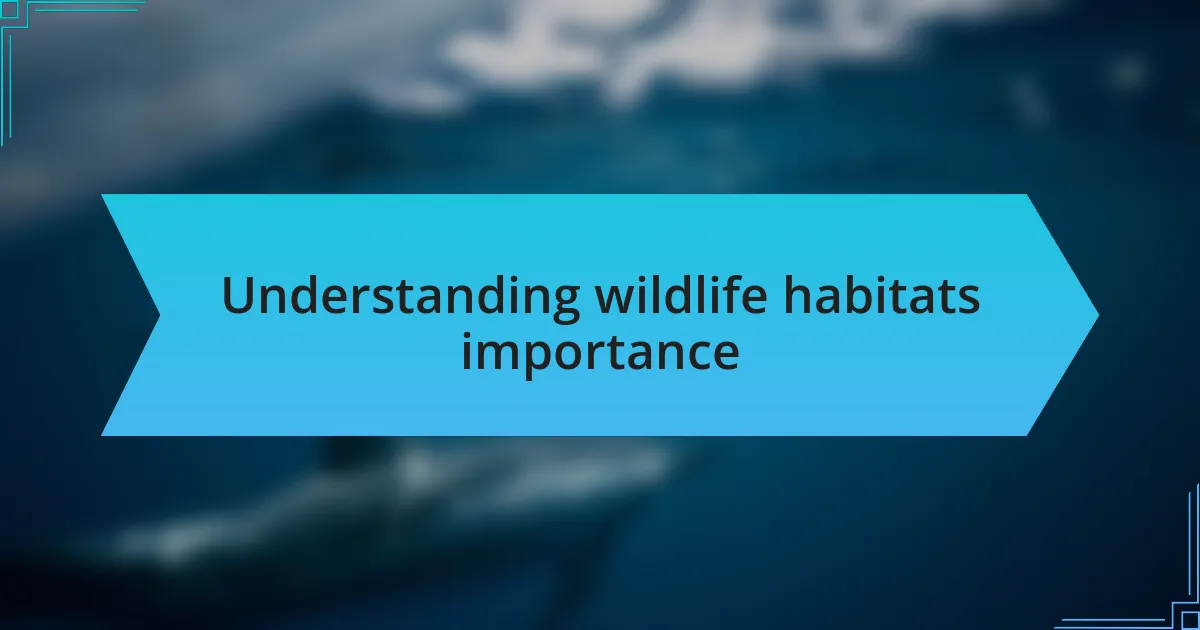
Understanding wildlife habitats importance
Wildlife habitats are the foundation for all forms of life. When I think about the local forest near my home, I realize just how vital these spaces are; they provide food, shelter, and breeding grounds for countless species. Have you ever stood quietly in a meadow and listened to the symphony of birdsong? It’s a reminder of how interconnected our ecosystems are.
These habitats also play a crucial role in maintaining ecological balance. For instance, wetlands help filter pollutants, while forests are natural carbon sinks that combat climate change. Sometimes, I find myself pondering: what would our world look like if we lost these natural spaces? It’s a chilling thought that underscores how essential it is to protect them.
Moreover, preserving wildlife habitats is not just about saving animals; it’s about safeguarding our own future. I often reflect on weekends spent hiking in untouched areas, where the beauty of nature rejuvenates my spirit. Isn’t it worth fighting for spaces that contribute to our well-being as much as they do for the creatures that rely on them?
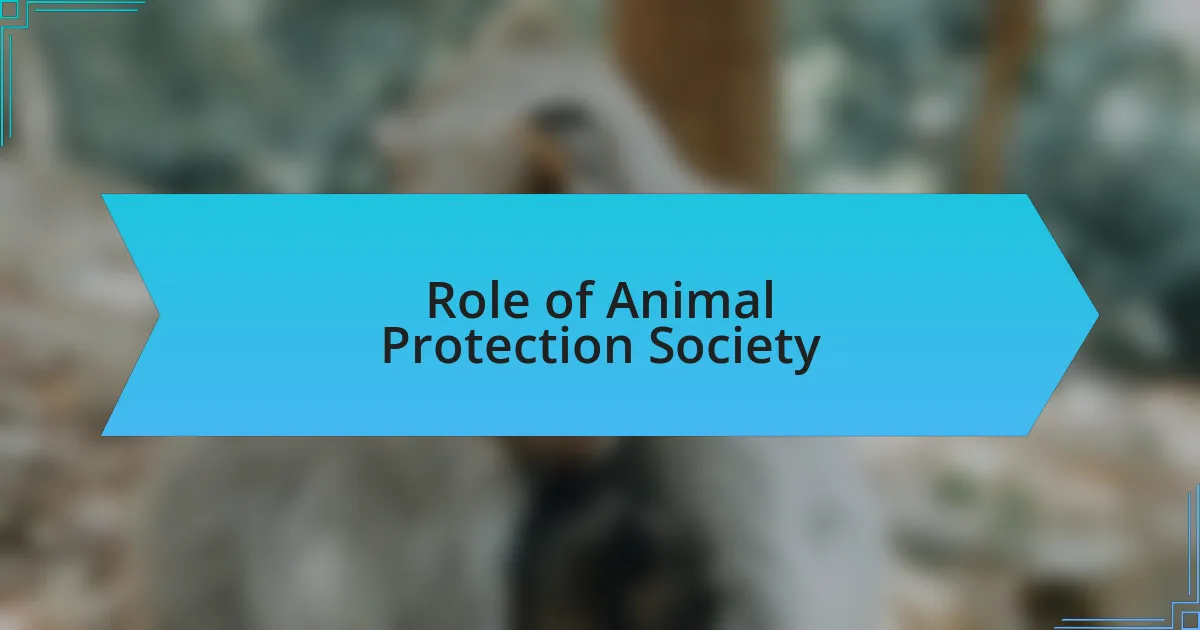
Role of Animal Protection Society
The Animal Protection Society plays a vital role in advocating for the preservation of local wildlife habitats. Through community awareness campaigns and educational programs, I see firsthand how they work to enlighten people about the importance of these ecosystems. There’s something heartwarming about watching someone connect the dots between local wildlife and their own daily lives; it’s like igniting a spark of curiosity that can lead to bigger change.
Additionally, the organization actively engages in habitat restoration projects. I remember volunteering for a tree-planting event that aimed to replenish a nearby disturbed forest. It was incredibly fulfilling to see volunteers come together, armed with shovels and determination, working towards a common goal. How often do we get the chance to leave a positive mark on our environment? This experience solidified my belief that collective efforts can indeed make a difference.
Furthermore, the Society collaborates with local governments to enforce wildlife protection laws. I often think about how easy it can be to overlook the regulations that safeguard endangered species. However, having groups like the Animal Protection Society advocating for these laws reminds me that we need a strong voice for the voiceless. It makes me wonder: if we all contributed just a little time or resources, how much more could we achieve in ensuring these habitats thrive for generations to come?
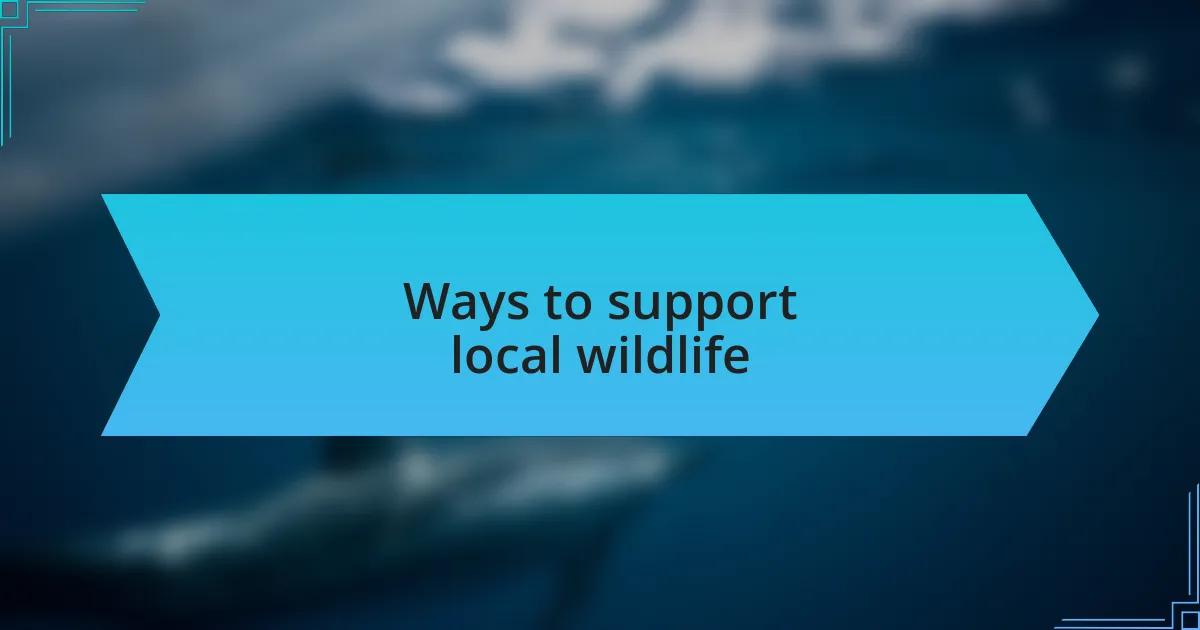
Ways to support local wildlife
Supporting local wildlife can take many forms, and one approach I’ve found particularly meaningful is creating wildlife-friendly spaces in my own backyard. Planting native flowers not only beautifies my surroundings but also attracts pollinators, like bees and butterflies. It’s satisfying to watch them flutter about, and it inspires me to think about how little changes in our personal environments can contribute to a larger ecological benefit.
I also encourage my friends and family to participate in local clean-up activities, like removing trash from parks or beaches. There’s something truly powerful about coming together for a cause that benefits the whole community, including wildlife. Reflecting on those days, I’m always reminded how fulfilling it feels to see a beautiful, trash-free area where animals can thrive. Have you ever experienced the joy of watching wildlife flourish in a cleaner habitat?
Moreover, supporting local wildlife can involve something as simple as being mindful about our consumer choices. For instance, I’ve made a conscious effort to buy products that are sustainable and eco-friendly. It’s made me reflect on how every purchase can impact our natural world. Are we not all responsible for what we bring into our lives? By choosing local, ethically sourced products, we not only support businesses that respect wildlife but also pave the way for a healthier ecosystem.

Creating a wildlife-friendly garden
When I began transforming my garden into a wildlife-friendly haven, I initially focused on adding native plants. Watching the vibrant colors and diverse textures of these natural beauties thrive not only brings me joy; it’s a relief to know I’m providing essential food and habitat for local creatures. Have you ever noticed how quickly bees, butterflies, and even small birds find their way to a well-planned garden? It’s as if they recognize a welcoming environment the moment they approach.
One of my favorite features now is a small pond I created, which has become a gathering place for all kinds of wildlife. It’s incredible to sit quietly and observe frogs leaping in and out, while dragonflies flit above the water’s surface. I often reflect on how this simple addition supports not just the critters themselves, but my own well-being too. There’s a calming effect when surrounded by nature, don’t you think?
To make my garden as inviting as possible, I’ve also incorporated a few brush piles and rock shelters. These not-so-perfect features provide refuge for various species, which might seem counterintuitive at first. But I’ve learned that fostering these small ecosystems ultimately leads to a balanced environment where life flourishes. It leads me to wonder—what small changes could you make in your own outdoor space to attract and protect wildlife?
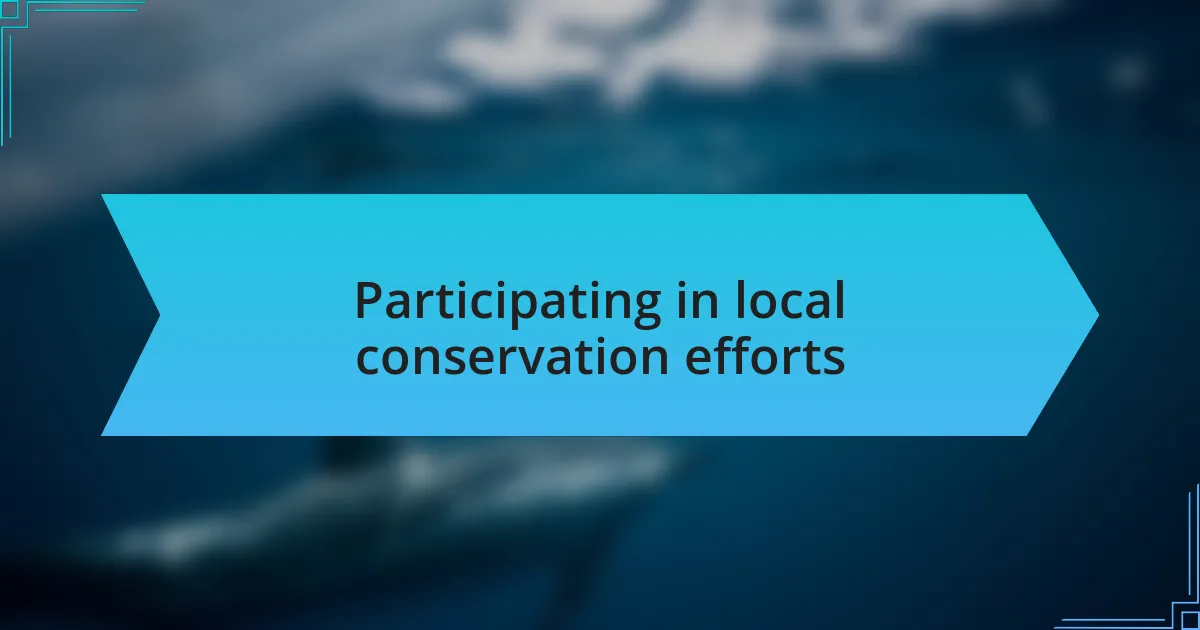
Participating in local conservation efforts
Engaging in local conservation efforts can be a deeply fulfilling experience. Recently, I joined a community tree-planting event, and it was amazing to see so many people come together with a shared purpose. Have you ever felt the satisfaction of planting a tree and knowing that it will provide shade and sustenance for generations to come? I remember hearing the laughter of children as they dug holes, their faces lighting up with each tree we planted—a memory I won’t easily forget.
Volunteering for local clean-up initiatives has also been rewarding. I’ve spent weekends picking up litter along rivers and parks, and witnessing the immediate impact brings a sense of accomplishment. There’s something powerful about transforming a space, restoring it to its natural beauty. It gets me thinking; what can each of us do in our own neighborhoods to enhance habitats for wildlife?
Moreover, I’ve participated in local citizen science projects that track wildlife populations. Collecting data on bird sightings or participating in butterfly counts opens my eyes to the richness of our local environments. This hands-on experience deepens my appreciation for the wildlife that shares our space. It often makes me wonder—how are you connecting with the nature around you?
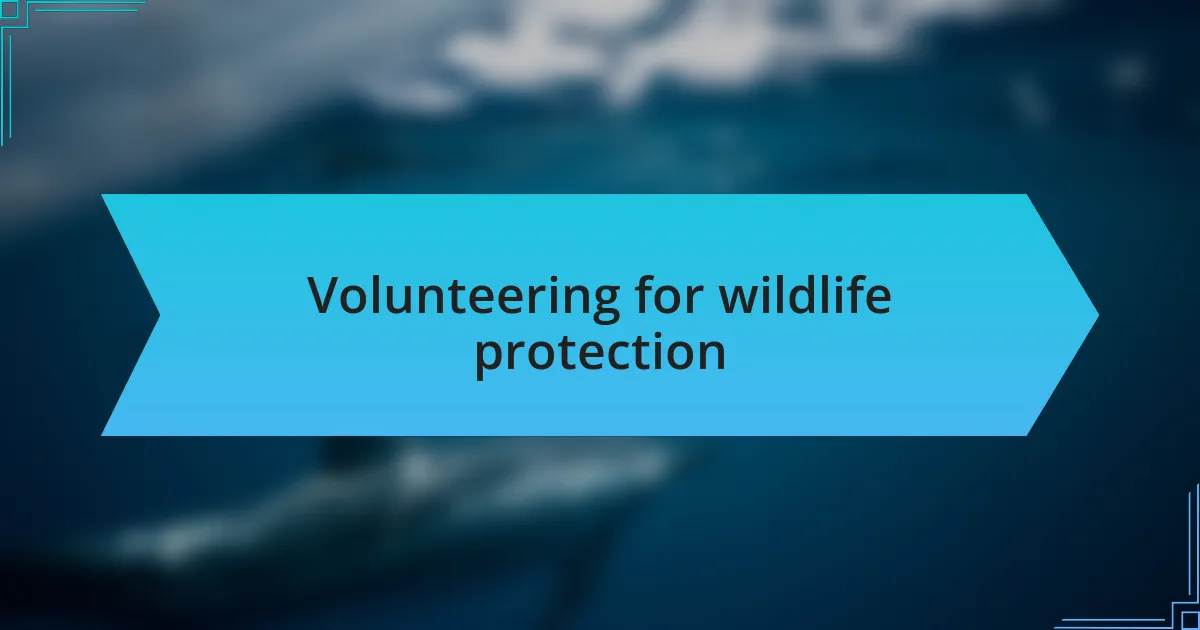
Volunteering for wildlife protection
Volunteering for wildlife protection really allows you to witness the difference you can make firsthand. I’ll never forget the day I helped rehabilitate injured birds at a local wildlife rescue. The moment I held a tiny, delicate fledgling in my hands, I felt an overwhelming sense of responsibility. Have you ever experienced the intuition that you’re doing something truly meaningful? That day, I realized every effort counts in helping these creatures thrive.
Participating in wildlife monitoring programs has also been an eye-opener for me. Recording observations of local species has given me a fresh perspective on just how fragile our ecosystems are. It’s fascinating to think about how something as simple as noting a fox track can contribute to understanding their population dynamics. What knowledge could you gain by becoming more attuned to the wildlife around you?
I also remember a day spent removing invasive plant species from a local wildlife area. Initially, it seemed like a daunting task, but as I worked alongside others, a sense of camaraderie developed. We were united by a common goal—restoring habitats for our local wildlife. Isn’t it amazing how these efforts can bring us closer to both nature and each other? Each pull of the invasive plants felt like a small victory, a step toward creating a healthier, more vibrant habitat for the animals that depend on it.
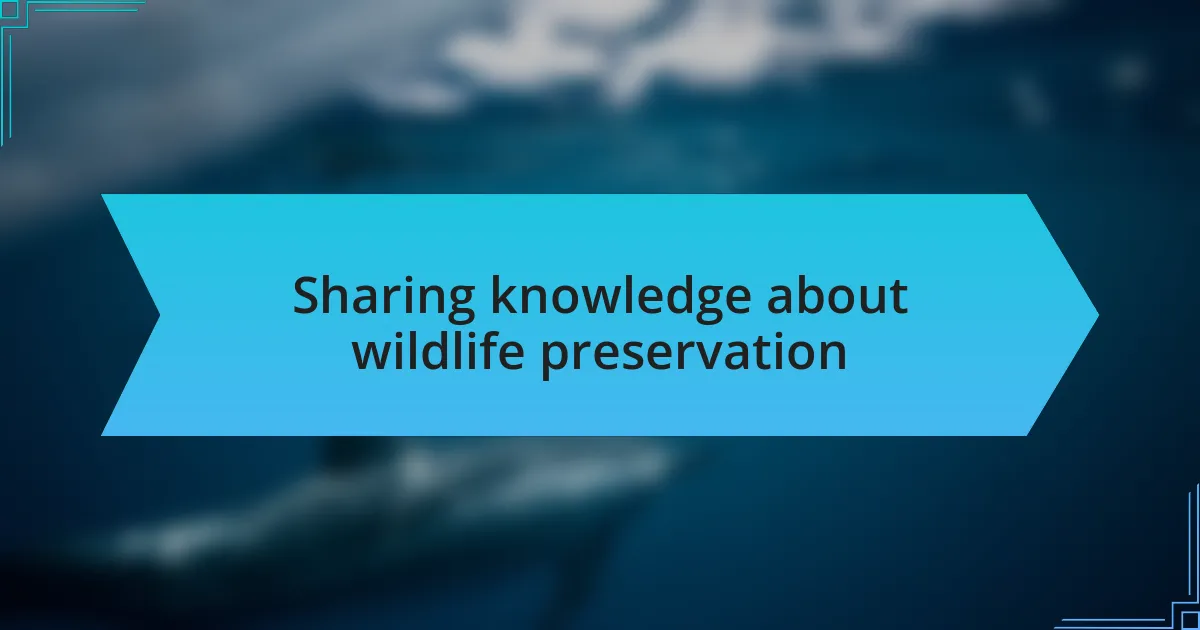
Sharing knowledge about wildlife preservation
Sharing knowledge about wildlife preservation is something I deeply value. I remember the first time I attended a local workshop on conservation techniques. Listening to experts share their experiences opened my eyes to the broader impact of our actions. It made me wonder: how many others are unaware of the simple steps they can take to support local ecosystems?
I’ve also found that discussions with friends about local wildlife can spark unexpected enthusiasm. One afternoon, while chatting over coffee, I shared what I’d learned about the importance of native plants in providing food and shelter for local fauna. Their curiosity led to a group outing where we identified various species in our neighborhood. How empowering it is to know that by sharing what we know, we can inspire others to engage with and protect their surroundings!
Creating social media posts about local wildlife has been another rewarding avenue for sharing knowledge. I often highlight unique species and conservation tips. The comments from readers expressing gratitude or sharing their own experiences remind me that every piece of information contributes to a larger awareness. Have you considered how your platform, no matter how small, can influence others and cultivate a community focused on wildlife preservation?